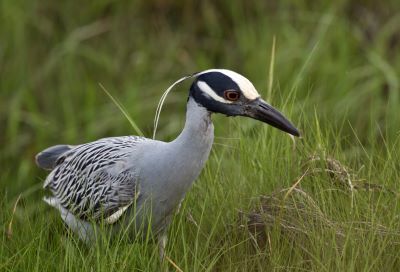
Good Natured: Night Heron
One of the really great things about life here at Good Natured World Headquarters is being able to read, usually via email but sometimes in a bona fide paper card or letter, about the adventures you all have as you go about exploring our natural world.
The correspondence might be prompted by a vacation to an exotic locale, or a visit to a local park or forest preserve. But more often than not, it's a walk through the yard or glimpse of something new in the garden that sets people writing—and sending photos.
(Side note: If you've written to me in the past and I've yet to respond, don't give up hope! I'm terrible at keeping up with mail and run perpetually behind. If you've asked a question and have yet to receive an answer, give me a little nudge—metaphorically speaking—and I'll do my best to respond.)
At any rate, a couple weeks ago I received a series of emails from Janice Zinanni, a Rock Falls, IL resident with a LOT of wildlife in her yard. The Good Natured column on rough-legged hawks prompted the first message, and what followed were pictures of cardinals, squirrels, a fox, a coyote, a Cooper's hawk…all very interesting and some quite funny, like the fox squirrel with its face pressed close to the screen of an open window.
But then Jan sent a photo called “Out by our pool" and, folks, I kid you not, I did a double take. And then a triple take. Because there in the Zinanni yard, atop a wooden fence, stood…an immature yellow-crowned night heron!
Holy state-endangered species, Batman!
Illinois actually is home to two different types of night herons, the black-crowned night heron, Nycticorax nycticorax, and the yellow-crowned, Nyctanassa violacea. Though members of the same family, Ardeidae (which also includes our other herons as well as egrets and bitterns) they are different enough to warrant different genera. When it comes to feeding, for example, yellow-crowns have a preference for crustaceans (crabs in coastal waters and crayfish inland) while black-crowns are described as opportunistic, chowing down on terrestrial and aquatic creatures and even, in some areas, landfill trash.
As for looks, there's a certain similarity between the two species. Adults are stocky, about 2 ft. long, with wingspans around 3 ½ ft. But when compared side by side, their differences become obvious. Whereas the black-crown has a, yes, black crown and a white face, the yellow-crown has a black head with white cheeks and a creamy yellow crown. Seen in silhouette, the black-crown appears hunched while the yellow-crown can be hunched, or display a more erect posture.
But when it comes to juvenile birds, those differences are less obvious. Blessed with cryptic coloration—all the better to stay camouflaged with—youngsters of the two species can be easy to mix up. In fact, when I first saw Jan's photo, I was thinking black-crown, not yellow.
The difference in posture was one clue, and the bill provided another. Black-crowned juveniles have bills that are dark on top but yellow or yellow-green below, while the yellow-crowns' are mostly black. There's also a slight difference in the markings, with black-crowns having elongated white spots as compared to the yellow-crown's white dots.
Something both species have in common, however, is their status as state endangered. While their numbers are plentiful to abundant in other parts of the country, here in Illinois—which admittedly is near the edge of their range—most populations are small; this detail makes them especially vulnerable to those devils of modern civilization, habitat loss and pollution.
That Jan and her husband Dean had a yellow-crowned night heron in their yard was pretty cool in itself. But when you factor in that the bird was a juvenile, which indicates at least one reproductive pair, their discovery becomes truly remarkable.
A few months ago I was made aware of an online form created by the Illinois Department of Natural Resources that helps track the incidence of threatened and endangered species in our state. This form is a way for all of us, whether we're nature professionals or ardent hobbyists or even casual observers that see something really neat, to contribute to the state's database of occurrences.
With Jan's permission, I filled out the form and included the photo she'd sent. Thanks to her willingness to participate, there's one more data point for the yellow-crowned night heron, a dynamic species that's clearly found something it likes in Rock Falls, IL.
The most recent iteration of Illinois' threatened and endangered species can be found here: https://www2.illinois.gov/dnr/ESPB/Documents/ET%20List%20Review%20and%20Revision/IllinoisEndangeredandThreatenedSpecies.pdf
The form for reporting T&E species can be accessed here: https://www2.illinois.gov/dnr/ESPB/Pages/ReportOccurrenceOfEndangeredOrThreatenedSpecies.aspx#:~:text=If%20you%20wish%20to%20report,.Kieninger%40illinois.gov.
Pam Otto is the outreach ambassador for the St. Charles Park District. She can be reached at potto@stcparks.org.

